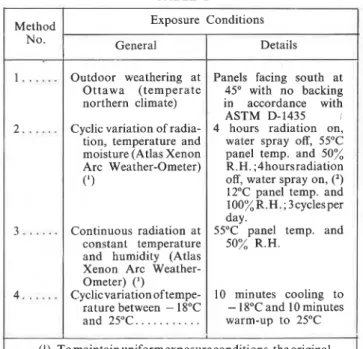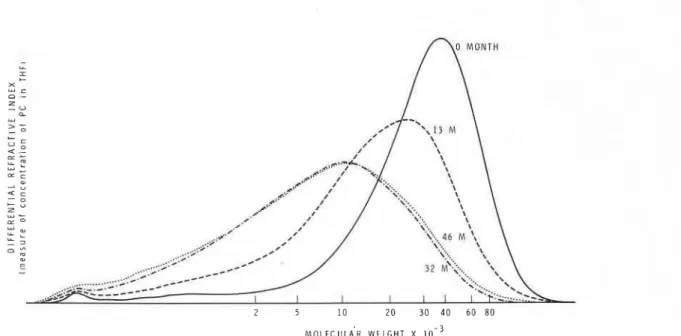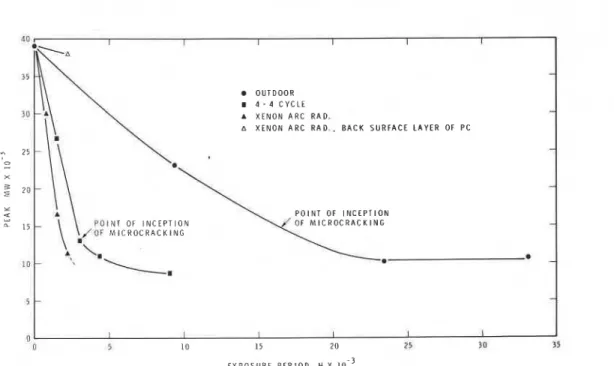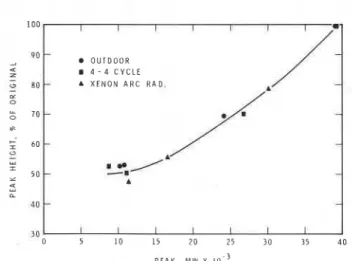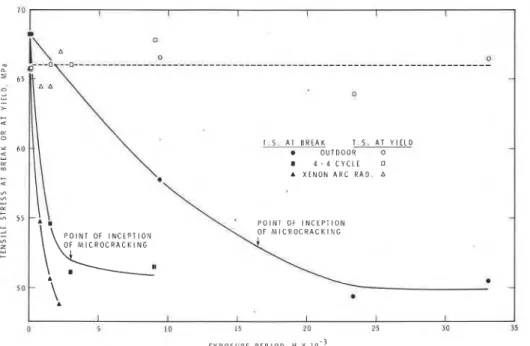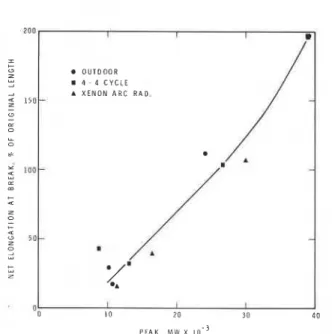Publisher’s version / Version de l'éditeur:
Materiaux et constructions. Materials and Structures, 10, 58, pp. 197-204,
1977-07
READ THESE TERMS AND CONDITIONS CAREFULLY BEFORE USING THIS WEBSITE. https://nrc-publications.canada.ca/eng/copyright
Vous avez des questions? Nous pouvons vous aider. Pour communiquer directement avec un auteur, consultez la première page de la revue dans laquelle son article a été publié afin de trouver ses coordonnées. Si vous n’arrivez pas à les repérer, communiquez avec nous à PublicationsArchive-ArchivesPublications@nrc-cnrc.gc.ca.
Questions? Contact the NRC Publications Archive team at
PublicationsArchive-ArchivesPublications@nrc-cnrc.gc.ca. If you wish to email the authors directly, please see the first page of the publication for their contact information.
NRC Publications Archive
Archives des publications du CNRC
This publication could be one of several versions: author’s original, accepted manuscript or the publisher’s version. / La version de cette publication peut être l’une des suivantes : la version prépublication de l’auteur, la version acceptée du manuscrit ou la version de l’éditeur.
Access and use of this website and the material on it are subject to the Terms and Conditions set forth at
Degradation of polycarbonate sheeting on outdoor exposure.
Relationship between changes in molecular weight and tensile
properties
Yamasaki, R. S.; Blaga, A.
https://publications-cnrc.canada.ca/fra/droits
L’accès à ce site Web et l’utilisation de son contenu sont assujettis aux conditions présentées dans le site LISEZ CES CONDITIONS ATTENTIVEMENT AVANT D’UTILISER CE SITE WEB.
NRC Publications Record / Notice d'Archives des publications de CNRC:
https://nrc-publications.canada.ca/eng/view/object/?id=981b5da4-9f4d-4732-b561-810f754f39bf https://publications-cnrc.canada.ca/fra/voir/objet/?id=981b5da4-9f4d-4732-b561-810f754f39bfSET
m
N 2 l d no,741
c. 2BrnG
ional Research Council o f
Canada
,nseil national de recherches du CanadaDegradation of polycarbonate sheeting
on outdoor exposure.
Relationship between changes
in molecular weight and tensile properties
R . S. YAMASAKI , A. BLAGA
I
Reprinted from
Materials and Structures (RILEM) Vol. 10, No. 58, July/August 1977 pp. 197-204
DBR Paper No. 741 Division of Building Research
Degradation of polycarbonate sheeting
BUtLnl."rrT; RFCFAf,CH
!
I
-
:
on outdoor exposure.
Relationship between changes
in molecular weight and tensile properties
R. S. YAMASAKI ( I ) , A. BLAGA ( I )To obtain better understanding of surface microcracking of polycarbonate (PC) glazing during
outdoor exposure, and to determine the effect of weathering on its fracture resistance, changes in molecular weight and tensile properties during outdoor and various artijicial weathering were studied. During outdoor weathering, the ultimate elongation and ultimate tensile stress decreased showing that P C became less ductile and more susceptible to fracture. The
occurrence of surface microcracking of PC is attributed to a combination of a decrease in
ultimate tensile stress and ductility of surface layer due to U V radiation, and alternating
stresses due, primarily, to temperature changes.
1 . INTRODUCTION
Polycarbonate (PC) sheeting is being used more and more to replace glass as glazing material in factories, schools and commercial buildings, primarily because of its greater resistance to breakage (impact strength is 250 times that of safety glass of the same thickness) and high transparency (slightly less than window glass). Its utility depends, of course, on the retention of these desirable properties throughout the service period.
It has been found at the Division of Building Research of the National Research Council of Canada that when UV-stabilized PC sheeting was subjected to outdoor weathering on a test rack, microscopic cracks developed on the surface after about 23 months. These cracks decreased the degree of transparency of PC. The formation of such surface microcracks was investigated with the use of a scanning electron microscope and is reported elsewhere [I]. This paper reports associated studies carried out to help explain the mechanism of surface microcracking and also to determine the effect of weathering on the resistance of PC to fracture.
( I ) Research Officers, Building Materials Section, Division of Building Research, National Research Council of Canada, Ottawa, Canada.
Literature shows that PC undergoes photochemical degradation when subjected to solar radiation [2]. Laboratory exposure of PC at 82OC has shown that photochemical processes, like the microcracking observed at DBR [I], are confined to the irradiated surface [3]. The molecular weight of unstabilized PC film decreased when irradiated with RS sunlamp (2) 141.
Under artificial weathering, PC sheeting underwent an abrupt decrease in its tensile strength and elongation to failure [5].
During outdoor weathering, PC is subjected not only to solar radiation, but also to other weathering factors such as temperature and moisture. Their role in the degradation process is not clear. It would be desirable to clarify the possible dependence of chemical degradation and changes in mechanical properties of PC sheeting on outdoor conditions, since it may lead to a better understanding of surface microcracking and of the possible reduction in resistance of bulk PC to fracture. It was decided, therefore, to determine the effect of radiation, temperature and moisture on the molecular weight distribution (MWD) of the surface layer, and on the tensile properties of PC sheeting.
(2) Mercury-vapor lamp emitting considerable energy in the 290
2 . EXPERIMENTAL PROCEDURE
2 . 1
.
Environmental exposure of UV-stabilized PCsheeting
Samples of clear commercial UV-stabilized glazing sheet (3.0 mm thick) of bisphenol A polycarbonate were used in this study.
Samples of PC were exposed to outdoor atmosphere on a test rack at Ottawa and to controlled artificial weathering conditions; details of exposures are given in table I.
2 . 2 . Determination of changes in molecular weight distribution of surface layer of PC by gel permeation chromatography
In a companion investigation, it was found that when PC was subjected to either outdoor or artificial weathering, it underwent microcracking which was confined to the top 5 to 10 p of the exposed sur- face [I]. To allow quantitative assessment of asso- ciated changes in molecular weight distribution (MWD), Waters Associates Model 200 Gel Permeation Chromatograph (GPC) fitted with six Styragel columns (lo5, 3 x lo4, lo4, 3 x lo3, lo3, 200
A
porosity) and employing tetrahydrofuran (THF) (Fischer certified) as solvent was used. It was operated at 25°C at an elution rate of 1 . 0 cm3/min. The top 5 pn layer of PC on the exposed side was shaved off from each test panel and dissolved in degassed THF to make up a 0.20%
solution in each case. Then 4-cm3 of the solution was injected into the 2-cm3 sample loop of the GPC with a syringe. The sample loop was kept open for 10 min rather than the usual 2 minutes to ensure that the sample had been completely transferred [6]. The agreement of the area of each chromatogram confirmed this [7]. The injection of the sample solution was repeated to check the analysis. In a few cases the unexposed (black) side of PC was also analyzed. An anti-evaporation device was installed [8] to minimize error in elution volume measurement due to variations in the rate of evaporation of the solvent from the siphon. The GPC was calibrated with narrow range polystyrene (PS) standards purchased from Waters Associates. A universal calibration curve applicable to PC was then prepared [9], i. e., log[ v ]
x peak molecular weight vs elution count where[ v ]
is the intrinsic viscosity. Intrinsic viscosities of PS and PC in THF were determined at 25.00°C with a calibrated Cannon-Ubbelohde semi-micro dilution type viscome- ter (Viscometer constant, 0.002 cSt/s) requiring only 1 cm3 of solution.2 . 3 . Determination of changes in tensile properties of PC
When PC is subjected to tensile loading it exhibits both elastic and plastic deformation. The former is characterized by complete recovery of strain when the load is removed; the latter by irreversible yielding and flow under load. These are illustrated in figure 1. The high impact strength of PC is attributed to its ability to undergo large plastic deformation [lo].
m y = TENSILE STRESS AT YIELD =TENSILE STRESS AT BREAK C Y = ELONGATION A T YIELD E b = NET ELONGATION AT BREAK
I F L h i t I C Y;G-Or4 I I I S T R A I N
Fig. 1. - Stress-strain diagram of PC sheeting at room tempe- rature.
To determine which deformation property of the PC is affected by weathering, elongation and tensile stress at yield as well as net elongation (seefig. 1) and tensile stress at break were determined with a Tinius-Olsen U-Celtronic tester, according to ASTM Method D638-72, employing type IV specimen at testing speed of 2.5 mm/min.
3 . RESULTS AND DISCUSSION
3 . 1
.
Changes in peak molecular weight of irradiatedsurface layer of PC during outdoor and artificial weathering
Figures 2 , 3 and 4 give molecular weight distributions of irradiated (front) as well as back surface layers of PC for various exposure periods to outdoor and artificial weathering. Each curve has two peaks, the higher one being the peak molecular weight (MW,) of PC and the lower one being due to small differences in inhibitor concentration in the pure solvent and solution.
TABLE I
Method No.
Exposure Conditions
General Details
Panels facing south at 45' with no backing in accordance with
ASTM D-1435 4 hours radiation on,
water spray off, 55°C panel temp. and 50% R.H. ;4hoursradiation off, water spray on, (')
12°C panel temp. and l00xR.H.; 3cyclesper day.
55'C panel temp. and 50% R.H. 10 minutes cooling to - 18°C and 10 minutes warm-up to 25'C 1 . . . . 2.
.
..
. . 3. . .
. . . ( I ) Tomaintainuniformexposureconditions,theoriginalsample racks were modified to allow positioning of the panels along the equator of the xenon arc.
(l) Deionized water at 9OC was sprayed on the irra-
diated (front) side of the panel (F-80 nozzle, flow rate
4 I/h/nozzle). -
-
Outdoor weathering at Ottawa (temperate northern climate) Cyclic variation of radia-
tion, temperature and moisture (Atlas Xenon Arc Weather-Ometer) ('1
Continuous radiation at constant temperature and humidity (Atlas
4 . . . .
. .
Xenon Arc Weather- Ometer) (')
Cyclicvariationoftempe- rature between - 18°C and 25°C.. . .
.
. . . .2 5 10 20 30 40 6 0 8 0 M O L E C U L A ' R W E I G H T x 1 0 . ~
Fig. 2. - Gel permeation chromatograms of the irradiated surface layer of P C at various periods of exposure to outdoor weathering.
Fig. 3. - Gel permeation chromatograms of the irradiated surface layer of P C at various periods of exposure to 4-4 cycle.
-
LL B A C K S U R F A C E L A Y E R I +- A f 2192 W E X P O S U R E X Y C n .-i
= o - L Y z-
+ C-
m u.=
= m L L I Y L rn C 0, 2 u u - = b- u L Y-
w-
w L L L I- : 3 ./. .." 0, w / ' E \. '.. \ '. - \, ".. .., \,'.,
\, '.. . \ \ ;..., \ '. 1 I I I,
,
.\':L;?<b>.Fig. 4. - Gel permeation chromatograms of the irradiated and back surface layers of P C at various periods of exposure to continuous xenon arc radiation.
n I I 1 I I I
1
0 5 10 15 20 25 30 35
E X P O S U R E P E R I O D . H x
Fig. 5. - Changes in peak MW of irradiated surface layer of
on
exposure to outdoor and artificial weathering conditions.Comparison of changes in MW, of PC on exposure to various weathering conditions 1s given in figure 5. For outdoor weathering, MW, decreased from 39,000 to 10,000 in about 32 months or 23,000 hours of exposure. Under artificial weathering methods 2(4- 4 cycle) and 3 (continuous xenon arc radiation), MW, also decreased, however, the corresponding exposure periods were shorter being 5,000 and 2,500 hours, respectively. For the surface layer on the back side of PC subjected to weathering method 3, there was relatively little change in MW, after 2,192 hours.
Radiation is common for all three exposure methods. During exposure of PC to weathering method 2(4- 4 cycle), total irradiation time required for MW to be reduced to 10.000 was actually 2,500 hours, wRich is
W A V E L E N G T H S , n m
Fig. 6. - Spectral energy distribution of xenon arc radiation
incident on, and UV-VIS transmission spectrum of P C sheeting (Xenon arc radiation from 1969 "Atlas Fade-Ometer and Weather-Ometer" catalogue).
the same as that for exposure to continuous xenon arc radiation (method 3). Finally, the main difference in weathering condition between the front and the back sides of PC during exposure to weathering method 3, is that the front is subjected to direct radiation including ultraviolet radiation (UV, 290 to 400 nm), while the back receives very little UV because most of it is absorbed within the PC sheeting (fig. 6). These observations support the view that radiation, and specifically UV radiation, is causing a decrease in MW, of stabilized PC under outdoor as well as artificial weathering conditions. They also indicate that the low temperatures and water spray applied in method 2 apparently did not significantly influence the shift in MW, and hence were probably not involved in the reaction.
Comparison of the exposure times required by three methods of weathering to reduce MW, of PC to 10,000 gives an acceleration factor with respect to outdoor exposure, of 4.6 and 9.2 for artificial exposure methods 2 and 3 , respectively.
3 . 2 . Changes in molecular weight distribution of irradiated surface layer of P C during outdoor and artificial weathering
From figures 2, 3 and 4, it can be seen that during exposure of PC to outdoor and artificial weathering, no part of the molecular weight distribution (MWD) curve of PC shifted to higher molecular weight (MW). This shows that chemical reactions which result in increase in MW, such as cross-linking, did not take place during either outdoor or artificial conditions. Further, the shift in MWD curve to lower MW supports the view that chain-scission took place ([2], [Ill).
In order to characterize the chemical changes taking place in the surface layer of PC during outdoor exposure, the changes in the differential refractive index for the peak molecular weight and the width at half- height of the MWD curve were determined. In general, the MWD curve obtained by a GPC apparatus is
I I I I O U T D O O R 4 - 4 C Y C L E A X E N O N A R C R A D . I
/.li
--
.
@ / * - -m A-
- I I I I I I IFig. 7. - Peak height VS peak MW of G P chromatograms of P C subjected to outdoor and artificial weathering conditions.
broadened by spreading factors (other than that due to change in MWD), such as zone spreading of the polymer species [12] and operational and instrumental factors [I31 so that in order to obtain true shape of the MWD curve, corrections must be made.
Tung (141 has shown that for polymers with a broad distribution ('polydispersity, d>2), which is the case for the PC used (d> 3) errors due to zone spreading are usually less than 10%. In the present study, the factor of interest is the relative change in the shape of the MWD curve on weathering rather than the absolute change. In such a case, the relative rather than the absolute variations in spreading factors are relevant. According to Bly [13] relative variations in spreading factors are insignificant. Changes in the height of the MW, and in the width at the half-height (in terms of MW units) of the uncorrected MWD curve were used, therefore, as a measure of the change in the shape of the MWD. These parameters are plotted with respect to MW, in figures 7 and 8. During outdoor weathering, both the height and the width at half-height decreased with decreasing MW,, indicating a lowering of concentration of MW, species and narrowing of MWD of PC with exposure, respectively. It can be seen that the change in peak height and the width at half-height for all three exposures may be described by a single curve. This indicates that the chemical reaction which results in a reduction in the MWD, and which takes place during all three exposures is the same, and is probably due to UV radiation. This is further evidence that wide differences in temperature and moisture conditions among three weathering methods were not involved in the reaction.
3 . 3 . Changes in tensile properties of PC during outdoor
and artificial weathering
In order to characterize the effect of outdoor and artificial weathering on the tensile properties of PC, changes in elongation at yield and net elongation at break (net ultimate elongation), and tensile stress at yield and at break (ultimate tensile stress) were determined for each exposure. These are illustrated in figures 9 and 10.
The elongation at yield of PC remains unchanged on exposure to outdoor weathering. This is also the case for exposure to artificial weathering conditions. On the
other hand elongation at break decreases with exposure, the rate of increase being highest with continuous exposure to xenon arc radiation, followed by exposure to 4-4 cycle and lowest with outdoor exposure, and shows that weathering adversely affects the plastic component of elongation. The decrease in net ultimate elongation amounted to as much as 90
%
of the original value.Tensile stress at yield also remains unaffected when PC is subjected to various weathering conditions. The ultimate tensile stress, however, decreases, the relative effect of weathering being the same as that for net ultimate elongation. The maximum decrease in ultimate tensile stress was 30% of the original value. The decrease in net ultimate elongation as well as ultimate tensile stress shows that on weathering PC becomes less ductile and more susceptible to fracture when stressed.
3 . 4 . Correlation of Changes in MW, and tensile
properties of PC
The correspondence between the effects of weather- ing on the tensile properties and on the MW, suggests a correlation between these characteristics of bulk PC. This correlation is shown in figures 11 and 12 for net ultimate elongation and ultimate tensile stress respectively, and appears to be the same for all three methods of weathering. This indicates that the decrease in tensile properties of bulk PC is due to the reduction in molecular weight of the surface layer brought about by UV radiation. This is in agreement with general findings that a decrease in the molecular weight of polymers increases their probability of fracture when stressed ([15], p. 129). Here, the decrease in molecular weight results in a decrease in tensile properties of the surface layer which in turn impairs the tensile properties of the bulk.
3 . 5 . Loss of tensile properties as a factor in surface microcracking of PC
As shown in figures 9 and 10, surface microcracking appeared during outdoor weathering [I] when the net
I00 1 O U T D O O R 2 90
-
rn 4 - 4 C Y C L E Z - A X E N O N A R C R A D . o 80 - 0-
0 a 7 0 - + I O 60-
- uFig. 8. - Width at half-height VS peak MW of GP chroma- tograms of PC subjected to outdoor and artificial weathering conditions.
Fig. 9. - Changes in net elongation at break and elongation at yield of PC on exposure to outdoor and artificial weathering conditions.
ultimate elongation and ultimate tensile stress of bulk PC decreased to 30 and 80% of their original values, respectively: Surface microcracking for expo- sure to 4-4 cycle took place at essentially the same values of these tensile properties (net ultimate elongation 25%; ultimate stress, 75%). In both cases microcracks form only on the exposed surface, providing further evidence of the dependence of the change in strength and elongation properties on the radiation-induced change in the MWD.
On the other hand no surface microcracking was produced by exposure of PC to continuous xenon arc radiation, although the loss in ultimate tensile stress exceeded those mentioned previously. This suggests that for cracks to form, an additional source of stress must be present. This was confirmed by subjecting a PC panel previously exposed to continuous xenon arc radiation to cyclic temperature changes ( - 18 to 25OC, method 4, table I) so as to induce alternating thermal
stresses. Surface microcracking was produced, but only on the irradiated side. The occurrence of surface microcracking of PC on exposure to outdoor or 4- 4 cycle, therefore, can be attributed to a combination of a decrease in ultimate tensile stress and ductility of the surface layer due to UV radiation and alternating stresses due, primarily, to temperature changes.
4 . CONCLUSIONS
1 . When UV-stabilized PC sheeting was subjected either to outdoor exposure, continuous xenon arc radiation, or xenon arc radiation-water spray (4- 4) cycle, the irradiated surface layer underwent a reduction in molecular weight by a common mechanism (chain scission). This reaction was induced by UV radiation. 0 1 S A T B R E A K T 5 A T Y I E L D O U T D O O R 0 4 - 4 C Y C L E 0 P O I N T OF I N C E P T I O N E X P O S U R E P E R I O D , H X 1 0 . ~
Fig. 11. - Net elongation at break VS peak MW of PC subjected
to outdoor and artificial weathering conditions.
2 . Each exposure produced a decrease in net ultimate
elongation and ultimate tensile stress of the P C (as much as 90 and 30
%
of the original, respectively), showing that weathering causes P C to become less ductile and more susceptible to fracture when stressed.3 . This reduction in the tensile stress and elongation to
failure is due to the reduction in the molecular weight of the surface layer.
4. Ranges of temperature and moisture conditions that prevailed during these exposures did not significantly influence the change in molecular weight. 5. Occurrence of surface microcraking of P C on exposure to outdoor or 4-4 cycle is attributed to the combination of a decrease in the ultimate tensile stress and ductility of the surface layer due to UV radiation and the presence of alternating thermal stresses.
ACKNOWLEDGEMENTS
The authors wish to thank R. C. Seeley and L. R. Dubois for their valuable assistance in securing the experimental data.
This paper is a contribution from the Division of Building Research, National Research Council of Canada and is published with the approval of the Director of the Division.
REFERENCES
[l] BLAGA A,, YAMASAKI R. S. - J. Mat. Sc., 11, 1976, p. 1513.
[2] TAHARA S. - Chem. High Polymers (Japan), 23, 1966,
p. 303.
[3] GEDEMER T. J. - Appl. Spectroscopy, 19, 1965, p. 141.
[4] GESNER B. D., KELLEHER P. G. - J. Appl. Polym. Sc., 13, 1969, p. 2183.
[5] TOMIKAWA M. - Chem. High Polymers (Japan), 20,
1963, p. 141.
O U T D O O R
I 4 - 4 C Y C L E
A X E N O N A R C R A D . /
Fig. 12. - Tensile stress at break V S peak MW of PC subjected to outdoor and artificial weathering conditions.
[6] SEGAL L., TIMPA J. D., WADSWORTH J. L. - J. Polym. Sc., A-1, 8, 1970, p. 3577.
[7] HAZELL J. E., PIERCE L. A., STEPELFELDT H. E. -
J. Polym. Sc. Part C, Polymer Symposia, No. 21, 1968, p. 43.
[8] HUDSON B. E. Jr. - J. Chrom. Sc., 1971, p. 185.
[9] GRUBISIC.Z., REMPP, P., BENOIT H. - J. Polym. Sc.,
B-5, 1967, p. 753.
[lo] CHRISTOPHER W. F., FOX D. W. - Polycarbonates,
Reinhold Publishing Corporation, New York, 1962, 182 p.
[ l l ] DAVIS A,, GOLDEN J. H. - J. Macromol. Sc., Rev.
Macromol. Chem., C3 (I), 1969, p. 49.
[12] OSTERHOUDT H. W., RAY L. N. Jr. - J. Polym. Sc.,
Part C, Polymer Symposia, No. 21, 1968, p. 5.
[13] BLY D. D. - J. Polym. Sc., Part C, Polymer Symposia,
No. 21, 1968, p. 13.
[14] TUNG L. H. - J. Appl. Polym. Sc., 10, 1966, p. 1271.
[15] BIKALES N. M. - Editor, Mechanical properties of
polymers., John Wiley et Sons, Fnc., New York 268 p.
Dkgradation des feuilles de polycarbonate exposkes aux intempkries. Relation entre les modifications du poids molkculaire et les propriktks en traction. - Les feuilles de polycarbonate sont de plus en plus utilisdes pour remplacer le verre en tant que matdriau de vitrage, principalement d cause de leur plus grande rtsistance au
bris et de leur grande transparence. L'utilisation du polycarbonate ddpend dvidemment du maintien de ses propridtts intdressantes tout le long de la pdriode de service.
A la Division des Recherches sur le Biitiment du Conseil National de Recherche du Canada, on a constatd que lorsque des feuilles de PC stabilisdes aux ultraviolets dtaient soumises aux intempdries, sur un cheualet d'essai, il se ddveloppait a la surface des microfissures aprds environ 23 mois. Ces fissures diminuent la transparence du P C . La formation de cette microfissuration de surface a dtd dtudide et ddcrite ailleurs. Cet article ddcrit des
dtudes mendes conjointement ajin d'aider a la comprdhen- sion du mdcanisme de cette microjissuration et de ddterminer l'effet de l'exposition aux intempdries sur la rbistance a la rupture du PC.
On a dtudid les modijications du poids moldculaire ddtermindes par chromatographie sur couche mince et les propridtds en traction du PC durant son exposition aux intempdries et a diverses ambiances artijicielles. Les rdsultats montrent que, au cours de l'exposition aux intempdries, la couche superjicielle irradide du P C subit une rdduction de poids moldculaire donnde par la hauteur de pics et de distribution du poids moldculaire du fait d'une rdaction de rupture de chaine provoqude par le rayonnement ultraviolet. Les conditions de tempdrature et d'humiditd n'injluencent pas notablement ces modijications. En outre, l'allongement 6 la rupture et la
contrainte de traction a la rupture diminuent, ce qui montre que l'exposition aux intempdries rend le P C moins ductile et plus susceptible d la rupture lorsqu'il est
sollicitd. Enjin, on a constatd que le PC doit &tre soumis a
des sollicitations alterndes pour que la microjissuration se produise.
On a constatd que le poids moldculaire donnd par la hauteur de pic correspondait avec la diminution des propridtds en traction tout le long de la pdriode d'exposition. Ainsi, la microjissuration de surface des feuilles de P C exposdes aux intempdries est attribude a
une combinaison de diminution de la contrainte
a
la rupture en traction et d'allongement d la rupture de lacouche supdrieure, par l'effet du rayonnement ultraviolet et de sollicitation alternde principalement due aux variations de tempdrature.
EXTRAIT DE LA REVUE (( MATERIAUX ET CONSTRUCTIONS )) - VOL. 10
